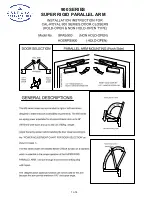
12
welding in a plane perpendicular to the direction of welding. In the case of filling the wide grooves in
the flat position
or the vertical end of the handle must be performed
lateral swinging movements. During welding, the welding gun should be conducted at a right angle
relative to the parts to be welded. Too large an angle of inclination may result in sucking air into the
liquid metal angle (from the vertical holder should be ≤ 10 °). Long arc welding reduces the depth of
penetration - the seam is wide and flat, and is accompanied by increased weld spatter.
Short arc welding (with the same current density) increase the depth of penetration - the weld is narrower,
and the spatter material becomes smaller. The welding speed is a parameter output at a given current
intensity and arc voltage, and maintaining the correct shape of the weld bead, and when the welding speed
may even be slightly changed, change the current or the arc voltage. The increase welding speed makes the
weld is narrower and decreases the depth of penetration, and with further increase in the face of flooding
occur. The largest welding speed, without undercuts, can be obtained by increasing the stick electrodes and
the inclination of the object up and down or tilt in the direction of the welding torch. Small welding speeds
cause that increases the depth of penetration, face width and height of the riser.
Excessive lengthening or shortening the arc can
cause unstable arc glow and poor weld quality. L1,
L2 - arc length
The depth of penetration is also significantly impact the
direction of welding - carrying the torch. H1, H2 - the
depth of penetration
The protective gas guards determines the efficiency of the welding area, but also of a process for transferring the metal in the arc, the
welding speed and the shape of the weld.
Inert gases argon and helium, although perfectly protect the molten weld metal against access of air, are not
appropriate for all applications GMA welding. By mixing in the appropriate proportions of helium or argon and
a chemically active gas obtained by changing the nature of metal transfer the arc to increase arc stability and
there is possibility to influence on metallurgical processes in the weld seam. At the same time it is possible to
significantly reduce or completely eliminate splash.




































